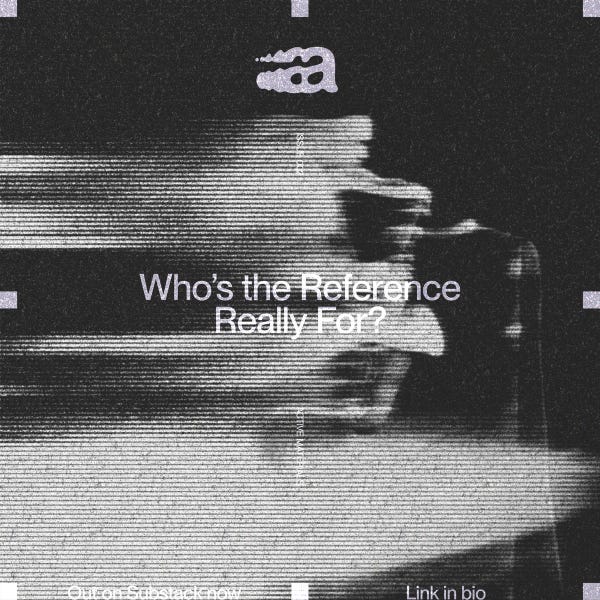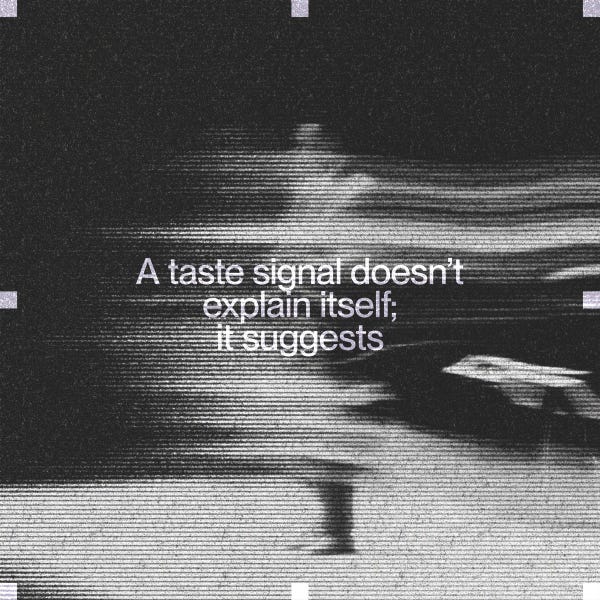Who's the Reference Really For?
On listening bars and the soft power of naming in culture and brands
Active Materials is a newsletter by Jordan Willis for creative strategists exploring the intersections of art, culture, and technology. Browse the archive to dive deeper.
If this found its way to you, and you’d like more, subscribe below.
On Listening Bars
Summer nightlife in London has its own rhythm. The heat draws us outside, softens our plans, and turns nights into one long drift between parks, pubs, and whatever else you and your friends catch on the breeze. Personally, it’s music that helps set the season’s pace.
In the wake of a post-COVID nightlife shakeup (club closures, shifting habits), sonic experiences outside the club have found new resonance. Foremost: listening bars. One of my favourites is Brilliant Corners.
Just below Dalston Junction, this low-lit listening spot serves casual Japanese food, quality drinks, and a corner-to-corner sound system to meet all your audiophile dreams. Inspired by Japanese izakayas, Brilliant Corners has spent the last decade creating a space where music takes the centre stage.
Listening bars have been thriving globally, fuelled by a turn toward community-led nightlife and slower, more deliberate ways of listening. But the thing I keep coming back to - is their names.
Because when the music stops, it’s often the name that echoes.
The Power of Names
Names aren’t neutral. They shape expectations, encode values, and quietly nudge perception. Psychologists call it “nominative determinism”: the idea that our names might influence our career or life path. In 2015, a group of British doctors found that names like “Dr. Payne” and “Dr. Gore” show up in fields like anaesthetics and surgery more often than chance would suggest. Of course, our names don’t seal fate, but it is funny to think it might nudge us toward it.
In branding, naming is often the first layer of storytelling. Some names evoke feelings (Apple, Nike); other names place the brand in a specific cultural, aesthetic, or ideological space. In the 90s, Death Cigarettes marketed itself as “an honest smoke”, stripping away illusion to become a cult symbol of anti-brand branding (the similar meta-awareness Liquid Death has obtained).
A ‘good’ name can help differentiate a brand and forge a strong connection with its intended audience. They curate the world the brand lives in, and hint at who should feel at home there.
Taste Signals
Looking across London’s listening bars, a trend emerges: unsurprisingly, many of them borrow their names from songs, albums, or figures in music. In a small sample of 16 venues, nearly half referenced music directly in their name. A quiet but telling signal:
Brilliant Corners, Dalston, East London: 1957 album by Thelonious Monk
Goodbye Horses, Islington, North London: 1988 song by Q Lazzarus
Space Talk, Farringdon, North London: 1976 song by Asha Puthli
The Marquee Moon, Dalston, East London: 1977 song by Television
All My Friends, Hackney Wick, East London: 2007 song by LCD Soundsystem
Spiritland, King’s Cross, North London: 1977 song by Elkie Brooks
Bar Levan, Peckham, South London: After House legend Larry Levan
I think these sonic references act as a kind of taste signal. A taste signal doesn’t explain itself; it suggests. A dropped reference tells you what kind of space this is, and who it’s for. It rewards the listener who’s already tuned in.
So, what are these names really doing? Beyond the music reference, they act as social cues, subtle flags to those who’ll recognise the song, artist, or scene. These names speak to a specific kind of knowing, the kind that signals you're already inside. But in a world of endless reference, how long can that signal hold?
If you Know, You Know… You Know?
In culture, signals often matter more than statements. And few are more potent than the “if you know, you know” reference. There’s nothing new here. IYKYK tactics have long been around in fashion. In 1987, then-it-artist Jean-Michel Basquiat walked the Comme des Garçons runway. Now, the likes of Aimé Leon Dore’s lookbook casting consistently champions IYKYK friends and family of the brand.
In music, electronic music heads discuss the seemingly random titles of artists like Autechre, which often have inside-logic or inside-jokes to them. The more abstract, the greater the potential for a deep-cut reference.
We love to create resonance, and we also love to decode it. Scroll through reels and you’ll find breakdown artists unpacking every reference inside every reference in the same way Patrick Bateman and his peers obsess over minuscule differences in their business card designs.
These IYKYK moments hit the part of the brain wired for pattern recognition. That “aha” we get, it feels good. It gives us a small sense of belonging, of being in on something.
But as culture circulates faster, flatter, and more global – is the octopus eating its own legs? Are we endlessly referencing and decoding everything to stay relevant? Ironic, I know.
If deep-cut references give us a sense of connection, what happens when brands try to weaponize that feeling?
Back to A Subversive Attitude
Dazed Studio recently held an insights panel on ‘The Death of Cool?’, asking how brands can move beyond chasing “cool” and instead build relevance, resonance, and real connection. Standing out has never been harder. For brands, trying too hard just ends up looking like… trying.
‘Cool’ as we popularly know it took off through jazz culture in the 1940s-50s, think Miles Davis, Thelonious Monk. These artists used minimalism, improvisation, and restraint to shape a new kind of outsider identity. That anti-mainstream, outsider identity.
This idea of "cool" still holds weight, but it no longer means what it used to. Cool has become fragmented with the rise of the internet, and brands try to keep up. For the next generation, cool isn't about status, distance or polish; it's about authenticity, alignment, and intention.
What once felt subversive now feels strategic. Cool has been sliced, shared, and sold, but the hunger for resonance hasn’t gone anywhere.
The Joy of Decoding
In a ‘post-cool’ era, authenticity drives cultural relevance. Maybe then, that’s why we love the reference. What’s more authentic than a deep cut? It shows you know, and that you care. For audience members that get it, maybe it lets us in on what you love, and invites us to feel it too.
It’s no surprise that listening bars, communal spaces that champion their style after eras that associated their idea of ‘cool’ with subversive attitudes, are now the very spaces that young people seek out – redefining cool around values of community.
Music sets the pace, but names set the tone. They whisper something about what and who belongs. And the reference? Maybe it’s just a quiet way of saying: you too?
Your Curiosity Means a Lot
Active Materials exists to build a community of curious individuals, people open to new ways of seeing, making, and understanding the world. Learn more about us here. In the archive, you can find other ideas to explore.
Enjoyed this? Send it to a friend.
Interested in collaborating or contributing?
Comment below or send me a message at hello@jordanwillis.xyz to get in touch.








